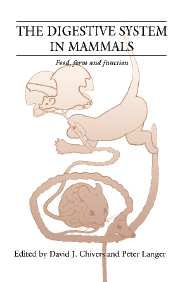Book contents
- Frontmatter
- Contents
- List of contributors
- Preface
- Part I Introduction
- Part II Food
- 5 Foods and the digestive system
- 6 Classification of foods for comparative analysis of the gastro-intestinal tract
- 7 The ‘carnivorous’ herbivores
- 8 Nutritional ecology of fruit-eating and flower-visiting birds and bats
- 9 Herbivory and niche partitioning
- 10 Taste discrimination and diet differentiation among New World primates
- 11 Potential hominid plant foods from woody species in semi-arid versus sub-humid sub-tropical Africa
- Part III Form
- Part IV Function
- Part V Synthesis and perspectives
- Index
6 - Classification of foods for comparative analysis of the gastro-intestinal tract
Published online by Cambridge University Press: 18 March 2010
- Frontmatter
- Contents
- List of contributors
- Preface
- Part I Introduction
- Part II Food
- 5 Foods and the digestive system
- 6 Classification of foods for comparative analysis of the gastro-intestinal tract
- 7 The ‘carnivorous’ herbivores
- 8 Nutritional ecology of fruit-eating and flower-visiting birds and bats
- 9 Herbivory and niche partitioning
- 10 Taste discrimination and diet differentiation among New World primates
- 11 Potential hominid plant foods from woody species in semi-arid versus sub-humid sub-tropical Africa
- Part III Form
- Part IV Function
- Part V Synthesis and perspectives
- Index
Summary
When classifying food, the following questions are often asked:
What are the fields of study that need food classification?
What criteria have to be considered in this classification in different fields of study?
What is the discrimination (or resolution) of classifications in different fields: is it always similar, or is it necessary to recognise coarser- or finergrain classifications in different fields of study?
Food classifications are needed and applied in animal and human nutrition science, comparative physiology and ecology; they discriminate food characters with as much detail as necessary and/or possible. When classifying food materials, one should keep in mind that categorizing is always dangerous because it can restrict thoughts and ignore the origins of data used and required for the categories (Winkler, 1984).
The resolution (or discrimination) used in the classification of food can be based on physical properties, as well as chemical composition and food availability and shows the following tendencies in different areas of study.
Ecology Modern ecological studies emphasize, among other criteria, the availability or abundance of food in relation to area and time (e.g. Rattray, 1960; Osbourn, 1980; van Dyne et al., 1980; Owen-Smith, 1982, 1988; Duncan, 1991). Chemical and physical properties, and food availability, have to be given in as much detail as possible. Detailed data are often not available, however, and the ecologist has to work with low resolution (coarse grain) data. Perrin (1988) of the University of Natal, Pietermaritzburg supplied a highly differentiated trophic classification for the mammals living in the Eastern Cape Coast area of South Africa.
- Type
- Chapter
- Information
- The Digestive System in MammalsFood Form and Function, pp. 74 - 86Publisher: Cambridge University PressPrint publication year: 1994
- 4
- Cited by



